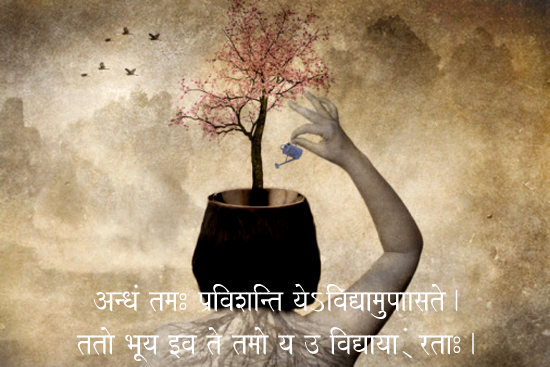Oct 30, 2025
Oct 30, 2025

Andham tamah pravisanti ye vidyam-upasate,
tato bhuya iva tamo ya u vidyayagm ratah: (9)
Those devoted to the worship of
Avidya or not-knowledge
enter into the blinding darkness of ignorance;
those who worship Vidya
or pure knowledge of the Atman exclusively,
seem to enter, as it were, into a greater darkness.
Commentary
| Pure and dry knowledge of the subject cannot satisfy our quest which we have to experience ourselves. The Truth has to be personally experienced; seeker has to attain it himself. |
In the shlokas nine through eleven, the term Vidya and Avidya has been used. Advaits presents Vidya as knowledge of Atman, which is Pure Awareness, Changeless and unborn Reality. The other term used is Avidya. It stands for not knowledge. It may be physical or material understanding of the ever changing universe. In Advait, Avidya is not a mere lack of knowledge as something negative but a positive nescience, not mere ignorance. It is an obscuring layer that covers the Brahman but is removed by Vidya, the Brahman jnana. According to Vedanta, both Vidya and Avidya combine into one without duality lead to the realisation of the Ultimate Truth, the Supreme Brahman. In the verses under consideration, the apparent contradiction between the two has been very beautifully drawn ultimately to conclude that Avidya is nothing but the absence of Vidya and exists as such.
Shloka 9
The seer suggests that Avidya is not knowledge. It may be full of good works; helpful and hopeful for mankind and the individual but as it is performed with the hope of some reward or return, it is binding and not liberating as Vidya is. In the absence of self–knowledge, Avidya is ignorance that ultimately deludes the performer. When consciousness objectifies itself and regards itself as its own object of observation, then there rules Avidya or ignorance.
This is the play of Prakriti, the physical and the material universe appearing as real and alluring. This nature or prakriti is three-fold. The three qualities of nature are Sattva, Rajas and Tamas. It has been subdivided into three each i.e. subtle, mild and gross. Thus the nature allures us into nine categories which together constitute the universe. Under the influence of Avidya, we get far away removed from our own self. Power of nescience, or ignorance is capable of creating a total confusion between the Real and the Unreal. We get confounded between the two and do not understand what is real and what is unreal.
Nescience can only afford the understanding of the unreal which through all its cognitions appear as real. It gives false information of the reality of the world appearance. However it can exist with Brahman as Brahman is knowledge. It cannot exist with nature, nor can individual soul be its focus. It is evident that true nature of Brahman is covered or obscured by Avidya and can be removed by Vidya. Nescience is not the real identity; even as oil in the sand is not a real identity. There cannot be any relationship between ignorance solely wedded to a life of material world and the Self or Atman. The Pure Consciousness cannot apprehend the inert object. The object may grant us pleasure but only temporarily and this pleasure is bound to end in pain as it increases our desires for more and more which we fail to fulfil. It is only when the notion of external knowable has been removed, Self shines or else it is the notion of inertia or ignorance which throws the followers into blinding darkness.
The seer cautions us against going to another extreme, that of the study of scriptures, and extreme faith in rituals. It is the pursuit of Vidya, exclusive and singlehanded. Knowledge is easy to comprehend. The seer is speaking of Vidya as knowledge of gods but not as yet the knowledge of Brahman. People generally keep themselves wholeheartedly devoted to some god or rituals to keep off the delusion of worldly appearance, but this is not sufficient. Pure and dry knowledge of the subject cannot satisfy our quest which we have to experience ourselves. The Truth has to be personally experienced; seeker has to attain it himself.
All wisdom is born of spirit of self-enquiry. It dispels the non-understanding and the undivided intelligence shines in its own light. The wisdom has to arrive directly on the devotee, no transmitted knowledge can be sufficient for the real enlightenment. Self is self-luminous. When consciousness becomes aware of itself, there manifests the Intelligence itself. This is why the seer cautions us against taking resort to notions and other objects.
Any single minded pursuit to learning is a mental exercise. Mind and intellect both are inert and their pursuit cannot at all be enlightening unless it is soul directed. It has to be the outcome of self-enquiry, free from the relationship of any notion, concept or idea. Vidya and Avidya are both notions and have to be done away with on the path to Eternity. We have to realise the Infinite Consciousness and not these concepts. All notions and concepts have to go first. Hence those people given to one-sided worship of Vidya alone act in vain and it may be presumed that they fall as though in greater darkness. Even though a ritualistic and theoretically spiritualist, they remain near yet far away removed from the Infinite Brahman because of these notions and concepts that cover the effulgence of the Supreme.
The seer gives us a message that we rise above notions and concepts and sense of duality as the Truth is non-dual.
Previous: Isha Upanishad Shloka 8
Next: Isha Upanishad Shloka 10
Image (c) Gettyimages.com
24-Apr-2011
More by : Dr. R. K. Lahri

|
Came across 1st correct commentary on this shloka. Thanks |

|
thank you for this |